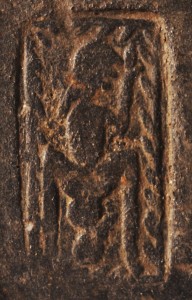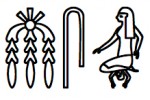 An archaeological excavation at Poggio Colla, an Etruscan site northeast of Florence, has uncovered a fragment of pottery engraved with two images of women giving birth. The fragment is over 2,600 years old which apparently puts it in the running for the oldest depiction of a woman giving birth in western art. According to Open University archaeology professor Phil Perkins, images of childbirth are rare in ancient art. There are later Greek and Roman representations but this depiction is several hundred years older than anything else extant.
An archaeological excavation at Poggio Colla, an Etruscan site northeast of Florence, has uncovered a fragment of pottery engraved with two images of women giving birth. The fragment is over 2,600 years old which apparently puts it in the running for the oldest depiction of a woman giving birth in western art. According to Open University archaeology professor Phil Perkins, images of childbirth are rare in ancient art. There are later Greek and Roman representations but this depiction is several hundred years older than anything else extant.
 (When I first read that I thought it couldn’t be right because not two weeks ago my mom showed me a picture she took at the Temple of Kom Ombo in Egypt of a bas relief depicting a woman mid-childbirth. I looked up the temple dates, though, and Kom Ombo turns out to be Ptolemaic, built in the 2nd and 1st centuries B.C. The Temple of Edfu, which has another childbirth relief, was built between the 3rd and 1st centuries B.C. Dendera’s Temple of Hathor, Egyptian goddess of childbirth, is Ptolemaic too.
(When I first read that I thought it couldn’t be right because not two weeks ago my mom showed me a picture she took at the Temple of Kom Ombo in Egypt of a bas relief depicting a woman mid-childbirth. I looked up the temple dates, though, and Kom Ombo turns out to be Ptolemaic, built in the 2nd and 1st centuries B.C. The Temple of Edfu, which has another childbirth relief, was built between the 3rd and 1st centuries B.C. Dendera’s Temple of Hathor, Egyptian goddess of childbirth, is Ptolemaic too.
 What about the hieroglyph msỉ? It’s the word for childbirth and is a logographic depiction of a woman giving birth. Does pictorial writing not count as an image or is the glyph a later addition to the Egyptian vocabulary? Those aren’t rhetorical questions. I searched but thus far have not found an answer. If y’all know, please to tell.)
What about the hieroglyph msỉ? It’s the word for childbirth and is a logographic depiction of a woman giving birth. Does pictorial writing not count as an image or is the glyph a later addition to the Egyptian vocabulary? Those aren’t rhetorical questions. I searched but thus far have not found an answer. If y’all know, please to tell.)
It was Professor Perkins who identified the fragment as a piece of Etruscan bucchero, a characteristic Etruscan black clay pottery that begins appearing on the archaeological record in the seventh century B.C.
The ceramic fragment is less than 1-3/4 x 1-1/4 inches (4 x 3 cm), from a vessel made of bucchero. Bucchero is a fine, black ceramic material, embellished with stamped and incised decorations, used to make eating and drinking vessels for Etruscan elites. Typically, stamped designs range from abstract geometric motifs to exotic and mythical animals. There are no known Greek or Roman representations of the moment of birth shown as clearly as the Poggio Colla example until more than 500 years later. The fragment dates to about 600 B.C.E. (Before the Common Era).
Because the site at Poggio Colla has produced numerous votive deposits, scholars are certain that for some part of its history it was a sacred spot to a divinity or divinities. The abundance of weaving tools and a stunning deposit of gold jewelry discovered earlier have already suggested to some scholars that the patron divinity may have been female; the discovery of the childbirth scene, because of its uniqueness, adds another piece of evidence to the theory.
The fragment was discovered by William Nutt, agraduate student at the University of Texas at Arlington, who is one of the lucky few selected for the Poggio Colla Field School, a hands-on archaeological plunge into the excavation of one of Etruria’s most fascinating sites, inhabited by Etruscans for almost the entire length of time they are known to have existed, between 700 B.C. and 187 B.C. Nutt is legally blind, very, very lucky and right about now, very, very happy.
“I was very grateful to be accepted to the summer program at Poggio Colla – it was my first archaeological dig,” said Nutt, who is attending UTA under a National Science Foundation fellowship. “I found the artifact at the beginning of my second week there. It was quite dirty, and we weren’t sure what it was until it was cleaned at the onsite lab and identified by Dr. Perkins. It was thrilling to find out that it was so significant. To make a discovery like that, which provides important new information about a culture we know so little about, is exactly what makes archaeology and anthropology so appealing.”
great dicover………….
As you and Professor Perkins note, the most intriguing set of questions here regards the context of Poggio Colla. This part of the world is full of sites spewing forth bucchero artefacts, so why did a childbirth representation appear here and (as yet) no place else? Poggio Colla is certainly not the only sacred spot in Etruria dedicated to a female divinity. And once again, we are reminded of the incredible complexity of Etruscan culture. This fragment is quite early–pre-Roman and even pre-Greek–evidently referring to indigenous beliefs and practices.
What a wonderful find, and to have been discovered by a graduate students – how incredible for him. The images remind me a little of the sheela-na-gigs, found carved in stone buildings from 11th-12th century Ireland, which although not explicitly depicting birthing, are associated with fertility and “birthing stones.” Theories abound as to what the carvings of prominent female genitalia actually symbolized, everything from warnings against lust (since many of them were actually carved on stones above church doors), to evidence of the continuing influence of a pre-Christian mother goddess, to protection against evil, to viewing the “vulva as the primordial gate, the mysterious divide between nonlife and life,” especially since many were carved above gates, doors, or other portals.
>>Does pictorial writing not count as an image or is the glyph a later addition to the Egyptian vocabulary?<<
Perhaps pre-Ptolemaic Egypt doesn't count as Western?
I considered that possibility, but ultimately dismissed it because it’s simply impossible to cut Egypt out of the canon of Western art. There’s a direct, unbroken line between pharaonic statues and Archaic Greek sculpture, for instance. Every book, every class on Western art starts with Mesopotamia and Egypt.
.:.
The hieroglyph of the woman giving birth is encoded in the Gardiner Signlist as B3 and B4 and can be used as a logogram for m-s-y “birth” but is more often used as a determinative following the phonetic spelling of “m-s” as F31 (the 3 fox pelts) and S29 (the bolt of cloth).
SOURCE :
B3 and B4
http://en.wikipedia.org/wiki/List_of_hieroglyphs/B
F31
http://en.wikipedia.org/wiki/List_of_hieroglyphs/F
S29
http://en.wikipedia.org/wiki/List_of_hieroglyphs/S
.:.
You can see this for yourself is you paste the MdC string F31-S29-B3 into the text dialogue box on the Hieroglyphs.net Hierowriter page.
http://hieroglyphs.net/0301/cgi/pager.pl?p=04
.:.
The pictorial at the end of the hieroglyphs is called a determinant which puts the words into context. Some words have two meanings so the determinant confirms the meaning of the words or additionally to explain who is being born… for example, the flag could be added to describe a god is being born. Shem m Hetep Peace.